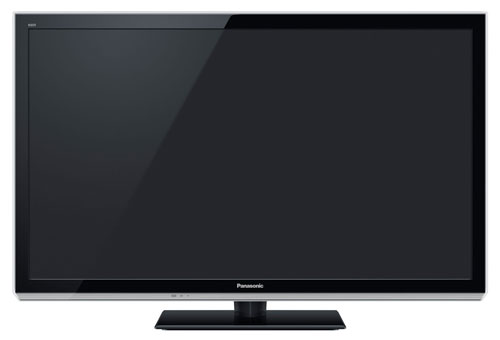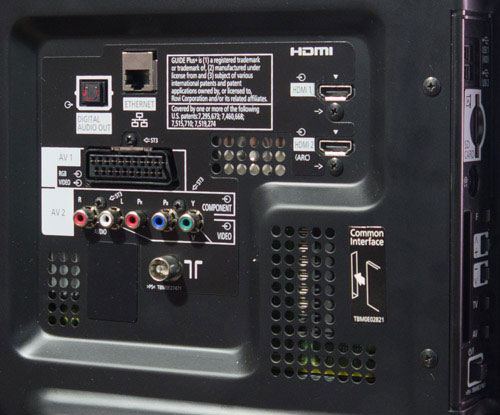We’ve looked through nearly all of Panasonic’s 2012 Viera plasma lineup already, with one exception being the the frequently requested UT50 series, which topped the interest of our readers when we asked them what they’d like to see scrutinised next. The TX-P42UT50B sits below the ST50, GT50 and VT50 Panasonic plasma TVs, although it still features a Full HD 1920×1080 panel, and DVB-T2 (Freeview HD) tuner.
<!-- google_ad_client = 'pub-2887677957235196'; google_ad_slot = '4990177225'; google_ad_width = 336; google_ad_height = 280; //-->
Compared to the ST50, the only main missing image quality related feature is the Infinite Black Pro anti-reflective screen coating. The tech specs also mention 6,144 steps of gradation compared to the step-up ST50’s 12,288, although we’ve found such differences to be subtle in the past. There are also only 2 HDMI inputs instead of the 3 found on the ST50, and the 4 from the GT50 and VT50.
In our opinion, the 2012 Panasonic plasma televisions are the best performing flat-screen HDTVs on the market today, owing to the value for money on offer and the comparatively benign shortcomings (which we’ll go into in this review). Can that high level of performance be maintained at this lower price point? Let’s find out.
Note: the firmware was updated to the most current version at the time of going to press (PAL12 PEAKS version 1.256). This had a miniscule effect on Greyscale tracking and Colour Luminance accuracy (for the better).
Note: The specific model we reviewed was the Panasonic TX-P42UT50B, which denotes the 3-pin-plug British version. Although we did not test the larger, 50-inch TX-P50UT50B, picture performance should be similar since the specifications of different models within the UT50 range are identical except for screen size.
The TX-P42UT50 looks like a mixture of old and new Panasonic designs. There’s the ubiquitous gloss black frame surrounding the panel, which will probably look just fine when the TV is new. Our review sample had a good amount of micro-scratches visible with even a small amount of room light, though, meaning that like with most gloss black finishes, it probably won’t look as new after a few wipes with a cleaning cloth. And the new? The more daring design touches include the Samsung-esque transparent “crystal” outer trim, and a metallic silver finish at the bottom of the panel. The stand is a basic gloss black affair.

The TXP42UT50B also dispenses with the ultra-slim profile shared by the ST, GT and VT50 series: the UT50 is about as deep as flagship plasmas from a few years ago. We don’t really see that as a problem, although it does mean that it won’t necessarily mount quite as close to the wall, if you plan on going down that route.
Packed with the TXP42UT50 is the older Panasonic remote control variant. It’s not backlit like the newer version (included with the ST50 and up) is, but on the plus side, it’s made of matte plastic, rather than the nonsensical gloss black finish on the new version (why style the one thing you’ll be touching most in a finish that picks up fingerprints so easily?). There is one difference, though: the UT50’s remote features the return of the dreaded Panasonic “N” button.
“What is the N button?”, you ask. Mostly found on Panasonic remote controls of years past, the N button is the one which completely resets the picture settings on the television, without asking if you’re sure. So powerful is the N button that you can even point it at Panasonic TVs whose own remote controls don’t feature it, and it will even wipe their picture settings too. What does the N stand for? We can only guess, but do not press it, and absolutely do not press it in front of your friend’s ISF-calibrated plasma.
Only 2 HDMI inputs? It’s true… we imagine a good number of UT50 users will be investing in HDMI switches. Of course, if you run all your devices through an HDMI AV receiver anyway, this limitation won’t be a problem.
 |
| Rear connections on Panasonic TX-P42UT50B |
Since it uses a non-slim chassis design, all of the TX-P42UT50’s connections are made directly to the back of the HDTV, without the need for breakout adapter cables. There’s no built-in wireless receiver either, meaning that you’ll need to use the wired ethernet port for the Viera Connect online “smart TV” functions.
The on screen menus on the Panasonic TXP42UT50B are the same as those found on the ST50 series. We’re delighted and relieved to see that the company’s “True Cinema” mode, which is the “don’t mess with the picture” option, is present.
Additionally, the [advance(Calibration)] option in the menus can be enabled to unlock some advanced picture setup controls, which include a 2-point Greyscale calibration menu, a basic Gamma curve selection (useful for tailoring the brightness distribution of the screen to suit brighter or darker viewing environments), and three-axis control (that’s over Saturation, Hue and Luminance) of the red, green and blue colour gamut points. To make any meaningful adjustments to the Greyscale and Colour options, though, do remember that you need access to a calibration meter and software – these settings can’t be correctly set by eye alone.
![[Picture] menu](https://www.hdtvtest.co.uk/news/wp-content/uploads/2018/04/hdtv_Panasonic-TXP42ST50_picture1.jpg) |
![[Picture] menu](https://www.hdtvtest.co.uk/news/wp-content/uploads/2018/04/hdtv_Panasonic-TXP42ST50_picture2.jpg) |
| [Picture] menus |
The implementation of the [Contrast] control has differed across Panasonic’s plasma ranges this year. On the ST50 series and below, raising it produces more light output from the panel, although taking it too high will crush out some details in bright white areas (although the lost details are not at the level commonly found in any video material, meaning that it’s a worthwhile trade-off for brighter rooms, or if you simply want to maximise the contrast ratio of the panel, at the slight expense of dynamic range). On the GT50 and VT50 series, which feature two “Professional” memory modes rather than the “True Cinema” mode, this doesn’t work, with these models having their light output capped in their most useful picture modes.
The UT50 is like the ST50 in this regard, meaning that it’s possible to tailor the screen brightness to a wider variety of viewing environments. However, even after turning the [CATS] (ambient light sensor) option off, the Panasonic TX-P42UT50B’s peak light output was a paltry 63 cd/m2 with a white test pattern window. Normally when we calibrate HDTVs, we aim for 120 cd/m2 so that everything is on a level playing field, making the TXP42UT50’s images half as bright as we’d like. Fortunately, turning the [Contrast] control up to its higher settings resulted in more realistic light output, although the upper extremes began to clip the aforementioned whiter-than-white shades. Given the choice of compromising screen brightness or compromising dynamic range, we chose the latter, since the whiter-than-white shades are not too common in video content. At the highest possible setting, the TXP42UT50B produced 120 cd/m2.
| Jump To: 1. DesignNext: Calibration3. Performance |
jQuery(document).ready(function($) { var toc = $("#tableofcontents").html(); $("#tablecontents").html(toc); });